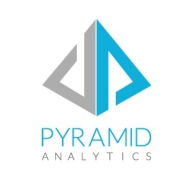

Teradata and Pyramid Analytics are both competitive products in the field of data processing and analytics. Teradata holds the advantage in handling large datasets with high-speed performance, while Pyramid Analytics leads in versatile data visualization and self-service analytics.
Features: Teradata is known for high-speed data processing and scalability, with capabilities like parallel processing and auto-partitioning. Its robust data management includes features like indexing and workload management. Pyramid Analytics enhances data visualization with self-service capabilities and supports versatile drill-down reports. It integrates predictive analytics and offers extensive compatibility with various data sources.
Room for Improvement: Teradata users desire better cloud integration, improved user-friendliness, and better handling of unstructured data. Pyramid Analytics users suggest improvements in the user interface, documentation, and ease of use, particularly for developers.
Ease of Deployment and Customer Service: Teradata supports on-premises, cloud, and hybrid environments but faces setup complexity. Its technical support is generally good. Pyramid Analytics also offers diverse deployment models but is criticized for requiring better documentation and streamlined support.
Pricing and ROI: Teradata is expensive, appealing to large organizations needing its extensive capabilities, providing good ROI despite the high cost. Pyramid Analytics is cost-effective for mid-sized to large companies with a favorable pricing structure compared to other BI tools.


The BI Office from Pyramid Analytics is a web-based governed data discovery and analytics platform. It integrates the four principal functions of any comprehensive BI strategy into a single, seamless application. Users can now analyze, present, report and predict on their data in a single application. Pyramid Analytics has native apps to cover the entire mobile spectrum, iOS, Android and Windows. With BI Office users can integrate SAP data with data from other sources giving them the right tools and better data to make data-driven decisions.
Teradata is a scalable data analytics platform designed to meet enterprise demands for large-scale data management and processing, focusing on performance, scalability, and security for complex query executions.
As a leading data warehousing solution, Teradata integrates advanced analytics enabling organizations to derive insights from massive datasets. It supports high-volume data workloads with its architecture optimized for analytical queries. Users benefit from its robust scalability, allowing seamless expansion as data grows. Teradata's SQL engine is compatible with a wide range of data types, ensuring flexibility in data analysis. With advanced security measures, it protects sensitive data across various environments, providing peace of mind to users handling critical information.
What are the most important features of Teradata?Teradata is widely used in industries like finance, telecommunications, and healthcare, where data-driven decisions are critical. Companies leverage its robust analytics capabilities to enhance customer experiences, streamline operations, and ensure compliance with regulatory requirements. In these sectors, quick access to data insights can significantly impact competitive advantage.
We monitor all BI (Business Intelligence) Tools reviews to prevent fraudulent reviews and keep review quality high. We do not post reviews by company employees or direct competitors. We validate each review for authenticity via cross-reference with LinkedIn, and personal follow-up with the reviewer when necessary.